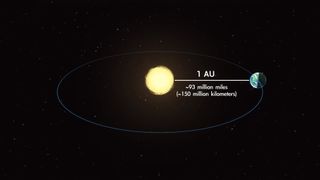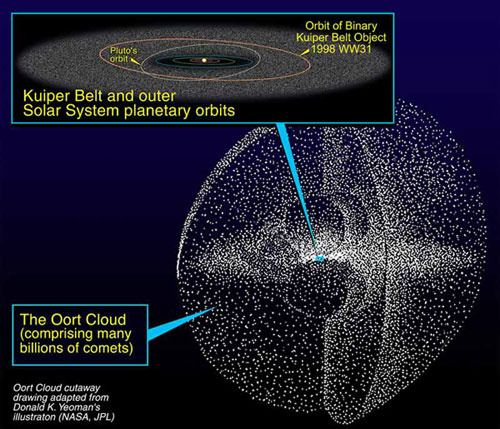Are Seasons Due To Changes In Distance Between The Sun And The Earth Throughout The Year?
How far is Globe from the dominicus?

Earth travels around the sun in an orbit that is slightly oval-shaped, known as an ellipse. Therefore, the planet'south distance from the dominicus changes throughout the year.
All the same, the average distance from Earth to the dominicus is about 93 one thousand thousand miles (150 million kilometers). Scientists also call this distance one astronomical unit (AU).
The universe is a big place, and sometimes researchers use the astronomical units to communicate how far celestial objects are separated from one some other. For case, Jupiter orbits about v AU from the dominicus.
Related: How big is Earth?
Related: What's the speed of World effectually the dominicus?
Earth's altitude from the sun changes
In early January, Earth reaches its closest position to the star. Astronomers call this point perihelion, and at this time Earth is about 91.4 1000000 miles (147.1 million km) away from the sun, co-ordinate to NASA.
Keep in mind that Earth's distance from the dominicus does non determine the seasons we experience; the seasons are adamant past the tilt of the planet's axis. This is why the season occurring in Earth's Southern Hemisphere is always in opposition to the season in the Northern Hemisphere.
Half a year after perihelion, World reaches its uttermost distance from the star, which is called aphelion. At that moment, the planet is approximately 94.5 million miles (152.one million km) from the lord's day. Aphelion occurs in early July.
Perihelion and aphelion average out to about 93 million miles (150 million km).
A new, more than precise astronomical unit
The International Astronomical Marriage (IAU) is an international nonprofit system that is tasked with, among many other things, defining astronomical constants. In Baronial 2012, IAU members voted to corroborate a more exact measurement of ane AU.
An astronomical unit is now more precisely divers as "a conventional unit of length equal to 149,597,870,700 meters exactly." That translates to roughly 92,955,807 miles (149,597,871 km).
Why was this conclusion necessary? The equation that had previously determined the value of an AU depended on information including the mass of the sun. But that value changes because the star is constantly transforming its mass into energy, according to 2012 reporting by Nature.
Einstein's theory of general relativity also throws a wrench in the evaluation of an AU because it argues that space-time is relative depending on the observer's location in the solar organisation. This complexity made it hard for planetary scientists working on models of the solar system.
The IAU's recently-adopted value is measured using the speed of light in the vacuum of space, which is constant.
The original calculation
The get-go-known person to measure the distance to the sun was the Greek astronomer Aristarchus of Samos, who lived from about 310 B.C. to 230 B.C. He used the phases of the moon to mensurate the sizes and distances of the sun and moon.
He postulated that when the one-half moon appears in Globe's sky, the eye of our planet and the centre of the moon create a line in space that forms a 90 degree bending with another line that could be drawn through infinite from the moon'due south centre all the mode to the dominicus's center. Using trigonometry, Aristarchus could determine the hypotenuse of a triangle based on those two imaginary lines. The value of the hypotenuse would provide the altitude between the lord's day and the World.
Although imprecise, Aristarchus provided a simple understanding of the sizes and distances of the iii bodies, which led him to conclude that the Earth goes around the sun, about i,700 years earlier Nicolaus Copernicus proposed his heliocentric model of the solar system.
In 1653, astronomer Christiaan Huygens calculated the altitude from Globe to the sun. Much like Aristarchus, he used the phases of Venus to find the angles in a Venus-World-sun triangle. His more precise measurements for what exactly constitutes an AU were possible thanks to the existence of the telescope.
Guessing (correctly, by chance) the size of Venus, Huygens was able to make up one's mind the distance from Venus to World. Knowing that altitude, plus the angles fabricated past the triangle, he was able to mensurate the distance from Earth to the sun. Yet, because Huygens' method was partly guesswork and not completely scientifically grounded, he commonly doesn't go the credit.
In 1672, Giovanni Cassini used a method involving parallax, or angular departure, to find the altitude to Mars and at the aforementioned time figured out the distance to the sun. He sent a colleague, Jean Richer, to Cayenne, French Guiana (located only northwest of the modern-solar day Guiana Space Center near Kourou) while he stayed in Paris. At the same time, they both took measurements of the position of Mars relative to background stars, and triangulated those measurements with the known distance between Paris and French Guiana. Once they had the distance to Mars, they could also summate the distance from World to the sun. Since his methods were more scientific, Cassini normally gets the credit.
These techniques are also why astronomers continue to utilize the distance from Earth to the lord's day as a calibration for interpreting the solar arrangement.
"Expressing distances in the astronomical unit allowed astronomers to overcome the difficulty of measuring distances in some concrete unit," astronomer Nicole Capitaine of Paris Academy told Space.com. "Such a practice was useful for many years, because astronomers were not able to make distance measurements in the solar arrangement as precisely equally they could measure out angles."
Across the solar system

The sun is at the heart of the solar organisation. All of the bodies in the solar arrangement — planets, asteroids, comets, etc. — revolve around information technology at various distances.
Mercury, the planet closest to the sun, gets every bit close as 29 million miles (47 million km) in its elliptical orbit, while objects in the Oort Deject, the solar system's icy shell, are thought to lie every bit far as 9.3 trillion miles (fifteen trillion km).
Everything else falls in betwixt. Jupiter, for case, is v.2 AU from the sun. Neptune is thirty.07 AU from the sun.
The altitude to the nearest star, Proxima Centauri, is about 268,770 AU, according to NASA. However, to measure longer distances, astronomers use light-years, or the distance that light travels in a single World-twelvemonth, which is equal to 63,239 AU. And so Proxima Centauri is nigh 4.25 light-years abroad.
Additional resources and reading
Watch a video explaining Aristarchus' arroyo to computing the distance from Globe to the sun. NASA's sun fact sheet provides bones statistics nigh our star and its solar arrangement exploration page offers details about solar science and missions studying the sun. Y'all tin can also explore catholic distances, within the solar system and beyond, with NASA.
Bibliography
- Brumfiel, G. "The astronomical unit gets fixed." Nature (2012). https://www.nature.com/articles/nature.2012.11416
- International Astronomical Union, "Measuring the Universe," accessed Jan. 21, 2022. https://world wide web.iau.org/public/themes/measuring/
- Kish, 1000. "A Source Book in Geography," accessed via Google Books. Harvard University Press, 1978.
- Luque, B. and Ballesteros, F. "To the Dominicus and beyond." Nature Physics (2019). https://www.nature.com/manufactures/s41567-019-0685-three
- NASA, "What Causes the Seasons?" July 22, 2021. https://spaceplace.nasa.gov/seasons/en/
Bring together our Space Forums to keep talking space on the latest missions, night sky and more than! And if you lot have a news tip, correction or comment, allow us know at: community@space.com.
Source: https://www.space.com/17081-how-far-is-earth-from-the-sun.html
Posted by: turkallynay.blogspot.com


0 Response to "Are Seasons Due To Changes In Distance Between The Sun And The Earth Throughout The Year?"
Post a Comment